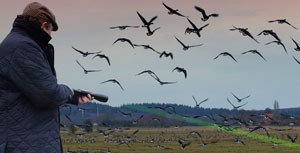Laser Used as Scarecrow of 21st Century to Ward off Seagulls

Shop and cafe owners across Devon and Cornwall are using water squirters to scare off gulls but the solution to the aerial menace may be more space-age.
Special laser guns could be the answer to scare off the gulls that plague our coastal resorts.
Natural England have told people trying to tackle the menace in the Westcountry that the “Agrilaser” does not need a licence to be used on the gull populations that are causing increasing problems in places such as Plymouth, Porthleven, St Ives, Exmouth, Sidmouth and Seaton.
The ‘Agrilaser’ portable laser bird repellant is being marketed primarily at farmers as a very 21st century version of a scarecrow, but it has been put forward as the answer to the gull problem in the south west.
The gun, which was developed in the Netherlands, fires a green beam that the gulls are afraid of, and they fly off and are wary to return.
Simon Prentis tried out the method when he moved from London to Cheltenham and found his new home plagued by gulls nesting on the roof of a block of flats nearby.
“I hit upon the laser idea myself, and then discovered this Dutch company have actually developed something specific for birds,” he said.
“I got up every morning and shone a laser at the birds on the roof across the way and found that it frightened them off. It has definitely worked, there are far fewer gulls this year at this spot than there were before.
“Whether it is the answer for everyone, I don’t know. It will need people to do it regularly, but I’ve noticed that these gulls are creatures of habit, and if they don’t like somewhere because they get a laser shone at them, they won’t go back.
“Councils are going to have to take a more proactive stance if they want to be effective in reducing the number of gulls,” he said. “Oiling eggs can only ever reduce the rate of increase, not stop the increase itself.
“I have had some success with lasers, which are harmless to the birds, but deter them from settling. Let’s hope that people are beginning to realise not just how big a problem this already is, but how much larger it will become as the birds increasingly colonise our inland towns.”
Natural England’s lead management wildlife advisor, Mary Hunter, gave the go-ahead for lasers to be deployed in this country, and said a range of measures were needed.
“There are remedial actions people can take to protect themselves from being dive-bombed by herring gulls, such as always covering their heads with an umbrella or similar when walking past problem nesting areas. I know that sounds silly during warm, sunny weather, but it is up to individuals to protect themselves,” she said.
Mr Prentis said that there needed to be a national strategy into the issue.
“It is now a problem in so many places, that we need proper research, and a proper way for every town to tackle this. I moved to Cheltenham and thought I was getting away from gulls in London, and I was shocked to discover they were here too.
“It’s not the food particularly, it is the success they have raising chicks in the safety of an urban environment,” he added.
This year, councils in Exmouth, Seaton and Sidmouth are spending £15,000 on hiring a falcon to chase away gulls.
Source: Western Morning News

